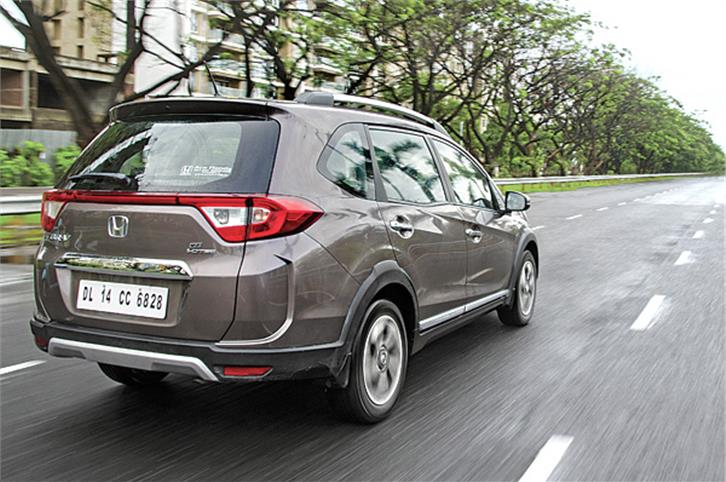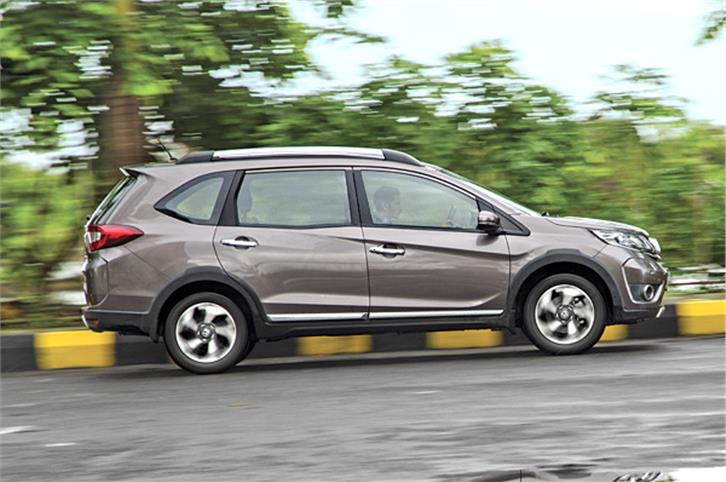After the immense popularity of the Duster and Creta, Honda has brought in its own contender with an ace up its sleeve – a third row of seats.
The upshot of the extra length and longer wheelbase, of course, is interior space. This is the only seven-seat crossover in its class, and that could be a huge benefit for owners with big families. In terms of space, it’s as good as a Mobilio (which was pretty good to begin with) and then some. For instance, with all seats in place, you get 223 litres, and can still fit a few soft bags or even one big suitcase in a pinch, in the boot. The other great thing is that it’s a very flexible cabin. The middle row slides as well as folds, with an easy one-lever action. The last row doesn’t fold flat into the floor, nor can it be removed, but even though you don’t get a fully level loading bay, you can’t deny the huge amount of space that’s possible if you want to turn your BR-V into a van. Another practical touch is that the loading lip is really low, making it easy to lob heavy luggage into the boot, and with the spare wheel bolted underneath the chassis, it doesn’t get in the way.
On to the seats themselves, rear to front. They’re all wrapped in premium-feeling leather on top-spec VX versions, and though they seem slim, they’re actually quite comfortable and supportive. The third row is impressive, both in how much knee and headroom it provides – some leeway is required from the sliding and reclining middle row – and in the fact that you don’t sit as knees-up as you might imagine; thank the BR-V’s monocoque construction for this. It is, of course, strictly for two, and width back here is not that great.
Width is better than you’d expect in the second row, given how narrow the car is, but it’s still not quite as good as what rivals offer. You do get two bottleholders in each door here, and overall, storage spaces are plentiful in this cabin. Headroom is ample, and even if you don’t slide the middle row all the way back to the full ‘luxury car’ setting, there’s more than enough legroom. There’s no AC vent between the seats like you get in a Hyundai Creta, but instead, an MPV-like roof-mounted AC cools the second and third rows; it’s actually more effective and doesn’t eat into legroom.
Hop into either of the front seats and you’ll feel like you’re in one of Honda’s sedans. The seats are snug and even with the driver’s seat raised all the way, it feels more like you’re driving a car than an SUV. Still, forward visibility is really good, although that can’t be said about the view behind; thanks to the small rear windscreen and how far back it is, reversing this long car can be a bit of a task. Cabin quality is on par with most other Hondas, which is to say the parts feel robust and well screwed together, but perhaps a little shy of Hyundai and VW’s lofty standards. The dash design is still a bit simple, but a big step up from the one you used to get in the Brio and Mobilio, the City’s three-ringed dials are employed here (backlit mercifully in white rather than garish blue) and the steering wheel is borrowed from the previous-generation City. It does feel great to hold though.
One area where the BR-V falls short is equipment. Sure, it gets two airbags and ABS as standard on all except the base petrol version (no ABS there), and yes, there are some welcome touches like keyless entry and go and projector headlamps. But by today’s high standard of automatic headlamps and wipers and self-dimming mirrors (none of which are available here), you really feel a little short-changed even on the top-spec cars.
Forget a touchscreen, what you get is a rather old-school audio system with USB, aux and Bluetooth and a monochrome, dot-matrix display. There is automatic climate control, but you get a very basic-feeling manual slider for the recirculation function. The biggest let-down, however, is that there’s no rear-view camera, nor are there parking sensors, and in such a big car with poor rear visibility, that’s a huge inconvenience.









Comments
Member Login
Personal Details
No comments yet. Be the first to comment.